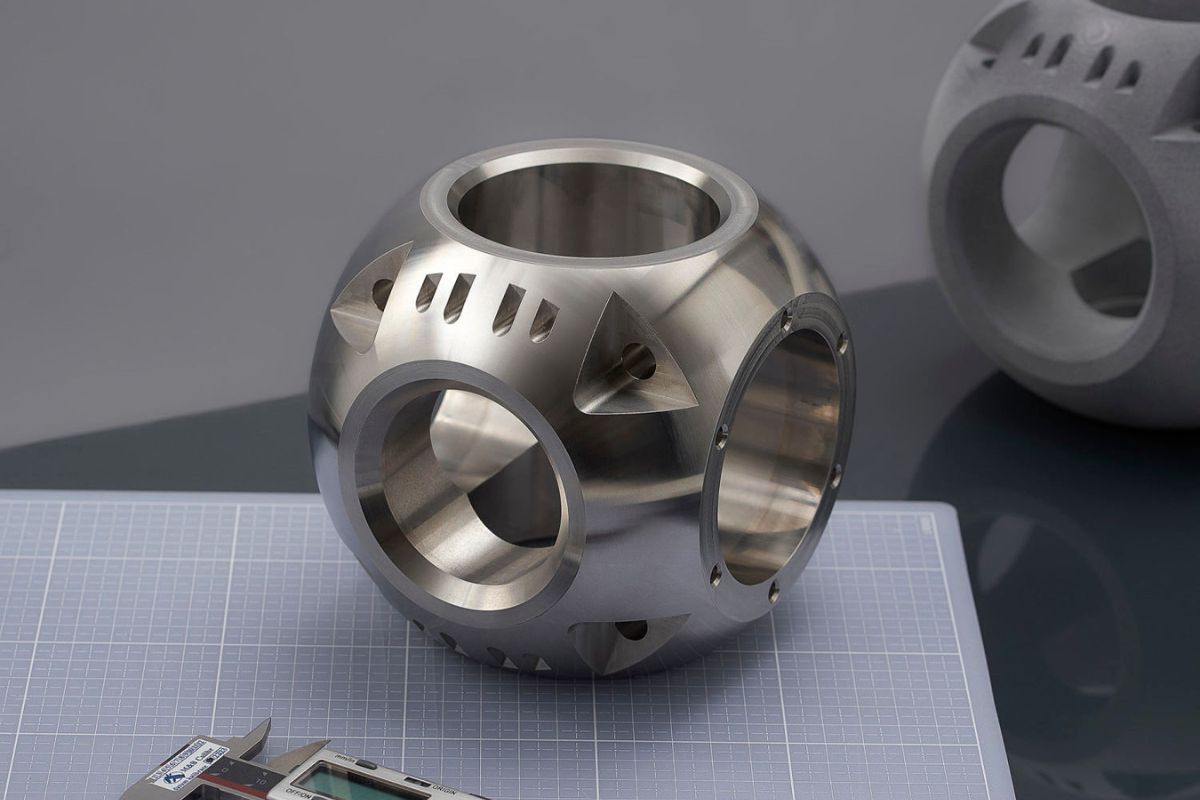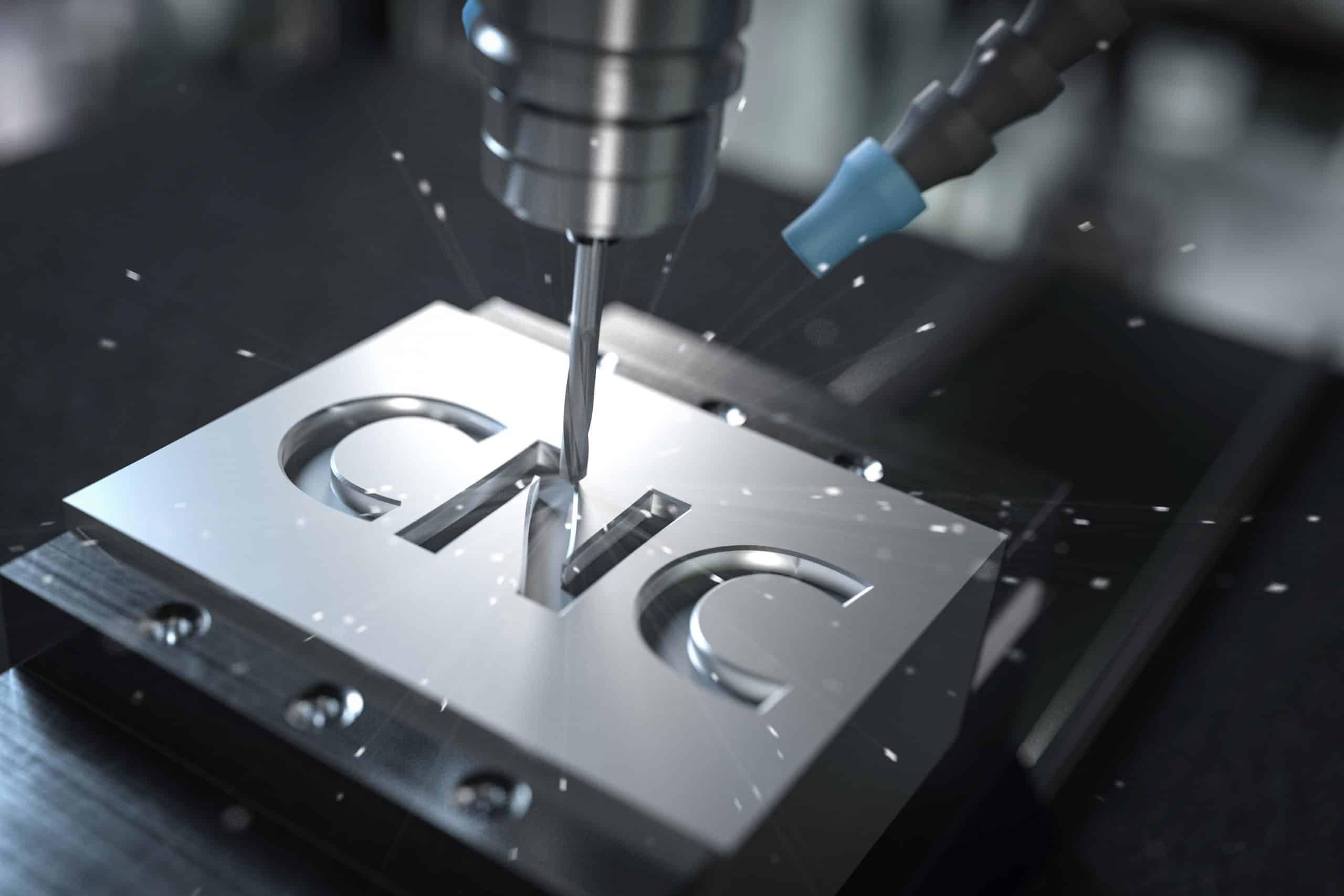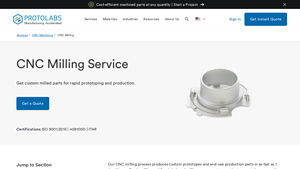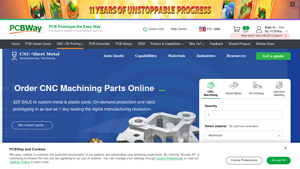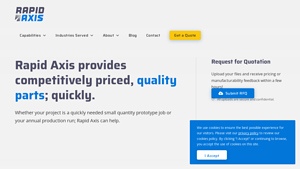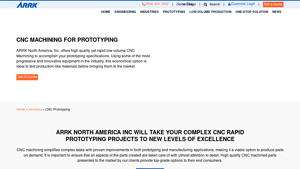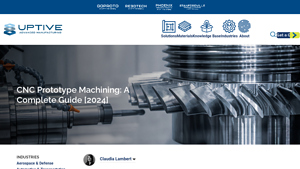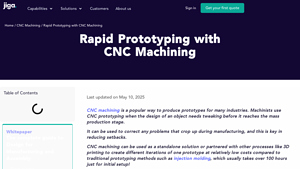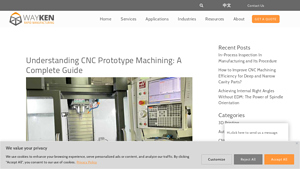Cnc Prototype Machining Guide: Type, Cost, Top List…
Introduction: Navigating the Global Market for cnc prototype machining
In an increasingly competitive global market, sourcing reliable CNC prototype machining services can be a daunting challenge for B2B buyers. Companies in Africa, South America, the Middle East, and Europe, particularly Germany and Saudi Arabia, face the pressing need to identify suppliers that not only meet quality and compliance standards but also offer cost-effective solutions tailored to their specific needs. This guide aims to demystify the complexities of CNC prototype machining by providing a comprehensive overview of the various types of machining processes, their applications, and the critical factors to consider when selecting a supplier.
From understanding the nuances of 3-axis and 5-axis milling to evaluating material options and surface finishes, this resource equips international buyers with the insights needed to make informed purchasing decisions. Additionally, we delve into essential topics such as supplier vetting, production timelines, and cost analysis, ensuring that businesses can confidently navigate the procurement process. By leveraging this guide, B2B buyers can streamline their sourcing efforts, mitigate risks, and ultimately enhance their product development cycles, paving the way for successful collaboration with CNC machining partners across the globe.
Understanding cnc prototype machining Types and Variations
| Type Name | Key Distinguishing Features | Primary B2B Applications | Brief Pros & Cons for Buyers |
|---|---|---|---|
| CNC Milling | Utilizes rotating cutting tools; 3-axis and 5-axis options available | Functional prototypes, production components | Pros: High precision, versatile material options. Cons: Longer lead times for complex designs. |
| CNC Turning | Rotates the workpiece against a stationary tool; ideal for cylindrical parts | Shafts, bushings, and complex geometries | Pros: Excellent for round parts, high efficiency. Cons: Limited to rotational shapes. |
| CNC Laser Cutting | Uses a focused laser beam to cut materials; ideal for intricate designs | Signage, prototypes, and thin materials | Pros: High accuracy, minimal material waste. Cons: Not suitable for thicker materials. |
| CNC Waterjet Cutting | Employs high-pressure water to cut; versatile for various materials | Aerospace, automotive, and stone cutting | Pros: Can cut thick materials, no heat-affected zones. Cons: Slower than other methods. |
| CNC 3D Printing | Layer-by-layer additive manufacturing; suitable for complex shapes | Rapid prototyping, customized components | Pros: Quick turnaround, design flexibility. Cons: May not match traditional machining tolerances. |
What Are the Key Characteristics of CNC Milling?
CNC milling is a subtractive machining process that employs rotating cutting tools to remove material from a workpiece. It offers both 3-axis and 5-axis capabilities, allowing for the creation of complex geometries and precise tolerances. This method is particularly suitable for producing functional prototypes and lower-volume production components, making it popular among B2B buyers looking for versatility and speed. When considering CNC milling, businesses should evaluate the lead times, as intricate designs can extend production schedules.
How Does CNC Turning Differ from Other Machining Types?
CNC turning is characterized by the rotation of the workpiece against a fixed cutting tool, making it ideal for producing cylindrical parts such as shafts and bushings. This method is highly efficient and can achieve excellent surface finishes, which is crucial for components requiring tight tolerances. B2B buyers should consider CNC turning for projects involving rotational shapes, but they should be aware that it may not accommodate non-cylindrical designs.
What Are the Advantages of CNC Laser Cutting?
CNC laser cutting utilizes a focused laser beam to cut through materials, providing high precision and the ability to create intricate designs. This method is particularly effective for thin materials and is widely used in signage and prototype development. While it offers minimal material waste and quick turnaround times, buyers should consider its limitations with thicker materials, which may not be suitable for this technology.
When to Choose CNC Waterjet Cutting for Your Projects?
CNC waterjet cutting employs high-pressure water to slice through various materials, including metals, plastics, and stone. Its primary advantage is the ability to cut thick materials without introducing heat-affected zones, making it ideal for applications in aerospace and automotive industries. However, B2B buyers should note that while it offers versatility, the cutting speed may be slower compared to other methods, which could impact project timelines.
How Does CNC 3D Printing Enhance Rapid Prototyping?
CNC 3D printing represents an additive manufacturing process that builds parts layer by layer, allowing for the creation of complex geometries that would be challenging with traditional machining methods. This technology is especially beneficial for rapid prototyping and customized components, enabling businesses to iterate designs quickly. However, buyers must consider the potential limitations in achieving the same tolerances as traditional machining, which could affect the functionality of certain applications.
Key Industrial Applications of cnc prototype machining
| Industry/Sector | Specific Application of CNC Prototype Machining | Value/Benefit for the Business | Key Sourcing Considerations for this Application |
|---|---|---|---|
| Aerospace | Manufacturing of complex components like brackets and housings | Rapid production of lightweight, high-precision parts critical for safety and performance | Certifications (e.g., AS9100), material specifications, lead times |
| Automotive | Production of functional prototypes for testing vehicle parts | Cost-effective validation of designs, reducing time to market | Tolerance requirements, material selection, scalability options |
| Medical Devices | Creation of custom surgical instruments and implants | High precision and biocompatibility ensure patient safety and regulatory compliance | ISO certifications, material traceability, and finishing options |
| Electronics | Prototyping of enclosures and PCB housings | Speeding up product development cycles and enhancing design flexibility | Design complexity, surface finish requirements, and electronic compatibility |
| Industrial Equipment | Development of tooling and fixtures for assembly lines | Improved efficiency in manufacturing processes and reduced downtime | Customization capabilities, material durability, and precision tolerances |
How is CNC Prototype Machining Used in the Aerospace Industry?
In the aerospace sector, CNC prototype machining is essential for producing complex components such as brackets, housings, and other structural elements. These parts often require high precision and lightweight materials to ensure safety and performance in flight. Buyers in this industry must prioritize suppliers with relevant certifications, such as AS9100, and a strong track record of working with specialized materials. Additionally, lead times are critical, as delays can significantly impact project timelines.
What Role Does CNC Machining Play in Automotive Prototyping?
CNC prototype machining is widely used in the automotive industry for creating functional prototypes that allow for rigorous testing of vehicle parts. This process enables manufacturers to validate designs and make necessary adjustments before full-scale production, thereby reducing time to market. Automotive buyers should consider tolerance requirements and material selection carefully, as these factors directly influence the performance and reliability of the final product. Scalability options are also essential for transitioning from prototypes to larger production runs.
Why is CNC Machining Crucial for Medical Device Manufacturing?
In the medical device industry, CNC prototype machining is utilized to create custom surgical instruments and implants that meet strict regulatory standards. The high precision required in these applications ensures patient safety and compliance with health regulations. Buyers should focus on suppliers that offer ISO certifications and can provide material traceability to guarantee biocompatibility. Additionally, various finishing options may be necessary to meet specific regulatory requirements.
How Does CNC Prototype Machining Benefit Electronics Development?
CNC prototype machining is instrumental in the electronics sector for prototyping enclosures and PCB housings. This method allows for rapid iterations in design, enabling companies to accelerate their product development cycles. Buyers in this industry need to pay attention to design complexity and surface finish requirements, which can affect the compatibility of electronic components. Ensuring that suppliers can meet electronic compatibility standards is also crucial for successful prototyping.
What Advantages Does CNC Machining Offer for Industrial Equipment?
For industrial equipment manufacturers, CNC prototype machining is vital for developing tooling and fixtures used in assembly lines. This application enhances manufacturing efficiency and minimizes downtime, leading to significant cost savings. Buyers must consider customization capabilities and the durability of materials when sourcing CNC machined parts, as these factors will directly impact the longevity and performance of the equipment in demanding industrial environments. Precision tolerances are also essential to ensure proper fit and function within the assembly process.
3 Common User Pain Points for ‘cnc prototype machining’ & Their Solutions
Scenario 1: Navigating Long Lead Times in CNC Prototype Machining
The Problem: One of the most significant challenges B2B buyers face in CNC prototype machining is long lead times. When developing new products, especially in competitive industries, time is of the essence. Buyers often find that traditional machining processes can take weeks or even months to produce the necessary prototypes. This delay not only impacts product launch timelines but can also lead to lost market opportunities and increased costs, especially if changes need to be made after initial prototypes are produced.
The Solution: To combat long lead times, buyers should consider working with suppliers that specialize in rapid prototyping. Choosing a CNC machining partner that offers quick-turn services—capable of producing parts in as little as one day—can drastically reduce the time from design to prototype. Ensure that you communicate your urgency clearly during the quoting process and inquire about expedited options. Additionally, leverage online quoting tools that allow for instant pricing and lead time estimates, enabling you to make informed decisions quickly. By collaborating closely with your supplier and utilizing digital tools, you can significantly streamline the prototyping process.
Scenario 2: Ensuring Precision and Quality in CNC Machined Prototypes
The Problem: Precision is critical in CNC prototype machining, especially when parts must fit together seamlessly in a larger assembly. B2B buyers often struggle with maintaining consistent quality and tolerances across multiple prototypes. Inconsistent dimensions can lead to costly reworks, delays, and ultimately, a compromised product quality. This is particularly crucial for industries such as aerospace or medical devices, where strict compliance with specifications is mandatory.
The Solution: To ensure precision and quality, buyers should prioritize suppliers with robust quality assurance processes. Look for manufacturers that provide documentation such as First Article Inspection (FAI) reports and material certifications. These documents verify that the produced parts meet specified tolerances and material requirements. Additionally, buyers should invest time in developing comprehensive design guidelines that align with the capabilities of the chosen CNC machining service. Engaging in early communication with your supplier can help identify potential design issues and allow for adjustments before production begins. This proactive approach minimizes the risk of errors and enhances overall product quality.
Scenario 3: Difficulty in Material Selection for CNC Prototyping
The Problem: Selecting the right material for CNC prototype machining can be daunting for B2B buyers. With a plethora of options available, including various plastics and metals, each with distinct properties, buyers often feel overwhelmed. Choosing the wrong material can result in prototypes that do not perform as expected, leading to wasted time and resources. This is especially concerning for industries that require specific material characteristics, such as heat resistance or mechanical strength.
The Solution: To simplify material selection, buyers should collaborate closely with their CNC machining provider. Engage in a thorough discussion regarding the specific requirements of your project, including intended use, environmental conditions, and mechanical properties. Suppliers often have extensive knowledge of material behaviors and can recommend suitable options based on your needs. It’s also beneficial to request sample parts made from different materials to evaluate their performance firsthand. By leveraging the expertise of your supplier and conducting practical tests, you can make informed decisions that align with your project requirements and ultimately enhance the effectiveness of your prototypes.
Strategic Material Selection Guide for cnc prototype machining
What Are the Key Properties of Common Materials Used in CNC Prototype Machining?
In CNC prototype machining, the selection of materials is crucial to achieving desired performance and functionality. Below, we analyze four common materials: Aluminum, ABS Plastic, Stainless Steel, and PEEK. Each material has unique properties, advantages, and limitations that impact their suitability for various applications.
Aluminum: A Versatile Choice for Lightweight Parts
Aluminum is widely used in CNC machining due to its excellent strength-to-weight ratio, corrosion resistance, and thermal conductivity. It is suitable for applications requiring lightweight components that can withstand moderate temperatures and pressures.
Pros: Aluminum is durable, easy to machine, and cost-effective for large production runs. It can also be anodized for enhanced surface protection and aesthetic appeal.
Cons: While generally strong, aluminum may not perform well under extreme temperatures and heavy loads compared to other metals.
Impact on Application: Aluminum is compatible with various media, making it ideal for automotive, aerospace, and consumer electronics applications.
Considerations for International Buyers: Compliance with standards such as ASTM and DIN is essential. Buyers from regions like Europe and the Middle East often prefer aluminum grades like 6061 and 7075, known for their mechanical properties.
ABS Plastic: Ideal for Prototyping and Functional Testing
Acrylonitrile Butadiene Styrene (ABS) is a popular thermoplastic used in CNC machining for prototyping due to its excellent impact resistance and ease of machining.
Pros: ABS is lightweight, cost-effective, and offers good dimensional stability. It is also easy to paint or finish, making it suitable for aesthetic applications.
Cons: ABS has lower temperature resistance compared to metals and can be susceptible to UV degradation over time.
Impact on Application: ABS is commonly used in consumer products, automotive parts, and electronic housings, where aesthetics and functionality are crucial.
Considerations for International Buyers: Buyers should ensure compliance with safety and environmental regulations, particularly in Europe, where REACH compliance is mandatory.
Stainless Steel: Strength and Corrosion Resistance
Stainless steel is known for its exceptional strength and corrosion resistance, making it suitable for demanding environments.
Pros: It is highly durable, can withstand extreme temperatures, and is resistant to oxidation and corrosion, making it ideal for applications in the medical and food industries.
Cons: Stainless steel is more challenging to machine than aluminum or plastics, leading to higher manufacturing costs and longer lead times.
Impact on Application: Its compatibility with harsh environments makes stainless steel ideal for components exposed to moisture, chemicals, and high temperatures.
Considerations for International Buyers: Compliance with standards such as ASTM A276 for stainless steel grades is crucial, especially for buyers in the Middle East and Europe, where quality and safety are prioritized.
PEEK: Advanced Performance for Specialized Applications
Polyether ether ketone (PEEK) is a high-performance thermoplastic known for its outstanding mechanical and thermal properties.
Pros: PEEK can withstand high temperatures (up to 260°C) and has excellent chemical resistance, making it suitable for aerospace, medical, and automotive applications.
Cons: The high cost of PEEK can be a significant barrier for some projects, and its machining requires specialized tools and techniques.
Impact on Application: PEEK is ideal for applications requiring high strength, rigidity, and resistance to harsh chemicals and temperatures.
Considerations for International Buyers: Buyers should be aware of material certifications and compliance with industry-specific regulations, especially in Europe and North America.
Summary Table of Material Selection for CNC Prototype Machining
| Material | Typical Use Case for cnc prototype machining | Key Advantage | Key Disadvantage/Limitation | Relative Cost (Low/Med/High) |
|---|---|---|---|---|
| Aluminum | Aerospace components, automotive parts | Lightweight and corrosion-resistant | Limited performance under extreme conditions | Medium |
| ABS Plastic | Consumer products, electronic housings | Cost-effective and easy to machine | Lower temperature resistance | Low |
| Stainless Steel | Medical devices, food processing equipment | Exceptional strength and corrosion resistance | Higher machining complexity and cost | High |
| PEEK | Aerospace, medical implants | High thermal and chemical resistance | Expensive and requires specialized machining | High |
This material selection guide provides a comprehensive overview for international B2B buyers considering CNC prototype machining. Understanding the properties, pros and cons, and compliance requirements of each material can significantly impact project success and product performance.
In-depth Look: Manufacturing Processes and Quality Assurance for cnc prototype machining
What Are the Key Stages in CNC Prototype Machining Manufacturing Processes?
CNC prototype machining is a sophisticated process that involves several critical stages: material preparation, forming, assembly, and finishing. Each stage plays a vital role in ensuring that the final product meets the required specifications and quality standards.
How Is Material Prepared for CNC Machining?
The first step in the CNC machining process is material preparation. This involves selecting the appropriate material based on the intended application, which can range from engineering-grade plastics to various metals such as aluminum, brass, and stainless steel. The material is typically supplied in the form of blocks or sheets, which are then cut down to size. Proper material selection is crucial because it directly impacts the machining process and the performance of the final product.
What Techniques Are Used in CNC Forming?
Once the material is prepared, the next stage is forming, which is primarily executed through CNC milling and turning. CNC machines, guided by precise G-code, remove material from the workpiece to create the desired shapes and features.
-
CNC Milling: This technique can be 3-axis or 5-axis, allowing for the production of complex geometries. The ability to machine parts from multiple angles increases design flexibility and precision.
-
CNC Turning: This process is ideal for cylindrical parts, where the material is rotated while a cutting tool shapes it. CNC turning is often used for components requiring symmetrical features.
These forming techniques ensure high precision and repeatability, crucial for prototype development and low-volume production.
How Is Assembly Handled in CNC Machining?
For prototypes that consist of multiple parts, assembly is the next significant stage. This may involve various methods, including mechanical fastening or adhesive bonding. Ensuring proper alignment and fit during assembly is crucial, as any discrepancies can lead to functional issues in the final product.
It’s essential to have clear documentation of assembly procedures to maintain consistency, especially when working with international suppliers who may have different practices.
What Finishing Options Are Available in CNC Machining?
Finishing is the final stage in the CNC machining process, where parts undergo surface treatments to enhance their appearance and functionality. Common finishing techniques include:
-
Anodizing: This process is often used for aluminum parts to improve corrosion resistance and surface hardness.
-
Plating: Techniques such as chromate plating provide additional protection against wear and corrosion.
-
Bead Blasting and Sanding: These methods improve the surface texture and aesthetics of the parts.
Selecting the right finishing option is vital for meeting both aesthetic and functional requirements of the end product.
What International Standards and Quality Control Measures Are Essential for CNC Machining?
Quality assurance in CNC prototype machining is non-negotiable, particularly for B2B transactions involving international buyers. Adhering to recognized standards such as ISO 9001:2015 ensures that manufacturers implement effective quality management systems.
Which Quality Control Checkpoints Should Be Followed?
Quality control (QC) typically involves several checkpoints throughout the manufacturing process:
-
Incoming Quality Control (IQC): This involves inspecting raw materials upon arrival to ensure they meet specified requirements.
-
In-Process Quality Control (IPQC): Continuous monitoring during the machining process helps identify defects early, minimizing waste and rework.
-
Final Quality Control (FQC): This step includes a thorough inspection of finished parts to ensure they comply with design specifications and quality standards.
What Testing Methods Are Commonly Used in CNC Machining?
Various testing methods are employed to verify product integrity, including:
-
Dimensional Inspection: Utilizing tools such as calipers and micrometers to measure critical dimensions.
-
Functional Testing: Ensuring the part performs as expected under simulated conditions.
-
Non-Destructive Testing (NDT): Techniques such as ultrasonic and X-ray testing can identify internal defects without damaging the part.
How Can B2B Buyers Verify the Quality Control of CNC Machining Suppliers?
For international B2B buyers, verifying a supplier’s quality control measures is crucial to ensure they can meet specific requirements. Here are several strategies to consider:
What Are the Best Practices for Conducting Supplier Audits?
Conducting supplier audits is one of the most effective ways to assess a manufacturer’s quality control processes. During an audit, buyers should evaluate:
-
Documentation: Review quality management certifications, inspection reports, and process documentation.
-
Process Evaluation: Observe the manufacturing processes in action to confirm compliance with specified standards.
-
Employee Training: Assess the training and qualifications of personnel involved in quality assurance.
How Can Buyers Access Quality Assurance Reports?
Many suppliers provide quality assurance reports upon request, detailing their inspection results and compliance with relevant standards. Buyers should look for:
-
First Article Inspection (FAI) Reports: These documents verify that the first produced part meets all design specifications before full-scale production begins.
-
Material Certification: Documentation proving that the materials used meet specific industry standards and regulations.
What Are the Quality Control Nuances for International Transactions?
B2B buyers from diverse regions such as Africa, South America, the Middle East, and Europe should be aware of specific quality control nuances:
-
Cultural Differences: Understand that approaches to quality assurance can vary significantly based on regional practices and standards.
-
Regulatory Compliance: Familiarize yourself with local regulations that may impact product quality and safety, such as CE marking in Europe or API standards in the oil and gas industry.
-
Language Barriers: Ensure clear communication regarding quality expectations, as misunderstandings can lead to costly errors.
In conclusion, a thorough understanding of the manufacturing processes and quality assurance measures in CNC prototype machining can empower B2B buyers to make informed decisions, ensuring they partner with suppliers who meet their exacting standards.
Practical Sourcing Guide: A Step-by-Step Checklist for ‘cnc prototype machining’
Introduction
Navigating the procurement process for CNC prototype machining can be complex, especially for international B2B buyers. This checklist aims to streamline your sourcing journey, ensuring you make informed decisions while securing high-quality prototypes. Each step is designed to guide you through critical considerations that will enhance your procurement strategy.
1. Define Your Technical Specifications
Clearly outline the dimensions, tolerances, and materials required for your prototypes. This step is essential because precise specifications will dictate the machining process and influence the final product quality. Consider including details such as:
- Material Type: Choose between plastics and metals based on application.
- Tolerances and Finish Requirements: Specify acceptable tolerances and surface finishes to ensure functionality.
2. Research Potential Suppliers
Investigate various CNC machining providers to find those that align with your project requirements. This is vital as not all suppliers offer the same capabilities or quality standards. Look for:
- Industry Experience: Evaluate their experience in your specific sector.
- Portfolio of Past Projects: Request case studies or examples of similar work.
3. Verify Supplier Certifications
Ensure that potential suppliers hold relevant certifications, such as ISO 9001:2015 or AS9100D. Certification verification is crucial for guaranteeing that the supplier adheres to high-quality manufacturing standards.
- Ask for Documentation: Request copies of certifications and compliance reports.
- Check Regulatory Compliance: Ensure they meet any specific regulations pertinent to your industry.
4. Request Detailed Quotes
Obtain quotes from multiple suppliers to compare pricing, lead times, and service offerings. This step is important to ensure you receive competitive pricing while understanding the full scope of services included.
- Inquire About Volume Discounts: If you plan on ordering larger quantities, ask about pricing tiers.
- Clarify Additional Costs: Ensure you understand any potential extra fees for finishing or shipping.
5. Evaluate Production Capabilities
Assess the technological capabilities of each supplier. Understanding their machinery and processes will help you determine if they can meet your specific needs.
- Machining Types: Confirm whether they can perform 3-axis, 4-axis, or 5-axis milling.
- Material Handling: Ensure they can work with the materials you require for your prototypes.
6. Assess Quality Control Measures
Inquire about the quality assurance processes in place at the machining facility. Strong quality control measures are essential to ensure that the prototypes meet your specifications and function as intended.
- Inspection Procedures: Ask about their inspection methods, such as First Article Inspection (FAI).
- Defect Rates: Request information on their historical defect rates and how they handle rework.
7. Establish Clear Communication Channels
Ensure there is a clear line of communication with the chosen supplier. Effective communication is vital for addressing any issues that may arise during the machining process and for ensuring that timelines are met.
- Point of Contact: Designate a contact person for regular updates.
- Language and Time Zone Considerations: Be mindful of potential language barriers and time zone differences, especially when dealing with international suppliers.
By following this checklist, you can enhance your sourcing strategy for CNC prototype machining, ensuring that you select a supplier capable of delivering high-quality products on time and within budget.
Comprehensive Cost and Pricing Analysis for cnc prototype machining Sourcing
Understanding the cost structure of CNC prototype machining is essential for international B2B buyers looking to optimize their sourcing strategies. This analysis breaks down the various cost components, identifies key price influencers, and offers actionable tips for buyers from regions such as Africa, South America, the Middle East, and Europe.
What Are the Key Cost Components in CNC Prototype Machining?
Materials: The choice of materials significantly impacts the overall cost. Common materials used in CNC machining include engineering-grade plastics and metals like aluminum, brass, and stainless steel. Prices vary based on material availability and market demand. For instance, specialty materials such as titanium may incur higher costs due to their limited supply.
Labor: Labor costs encompass the wages of machinists and operators skilled in CNC programming and operation. Skilled labor rates can vary widely by region; for example, labor costs in Europe might be higher compared to South American countries. This disparity can affect pricing strategies, especially for projects requiring high precision and expertise.
Manufacturing Overhead: This includes costs associated with maintaining machinery, utilities, and facilities. Overhead rates can differ based on the supplier’s location and operational efficiency. Suppliers in regions with advanced manufacturing technologies may have lower overhead costs, which can be reflected in their pricing.
Tooling: Tooling costs refer to the expenses related to the creation and maintenance of the tools needed for machining. Custom tooling can be a significant upfront cost, especially for unique or complex designs. Buyers should consider suppliers that offer tooling as part of their service to mitigate these costs.
Quality Control (QC): Ensuring the quality of machined parts often requires rigorous testing and inspection processes. Suppliers may charge additional fees for certifications and quality assurance measures. Buyers should inquire about these costs upfront, especially when sourcing from international suppliers with varying quality standards.
Logistics: Shipping and handling costs can vary based on the distance between the supplier and the buyer. International shipping can incur customs duties and import taxes, which should be factored into the total cost. Understanding Incoterms is crucial for buyers to clarify responsibilities for shipping and insurance.
Margin: Suppliers typically add a margin to cover their costs and ensure profitability. This margin can be influenced by competition, market demand, and the supplier’s reputation. Buyers should compare multiple quotes to gauge typical margins in the industry.
What Influences Pricing for CNC Prototype Machining?
Volume/MOQ: Pricing often decreases with higher order volumes. Buyers should negotiate minimum order quantities (MOQs) to benefit from economies of scale. Suppliers may offer discounts for bulk orders, making it worthwhile to consolidate purchases.
Specifications and Customization: Custom designs and complex specifications can lead to higher costs due to increased machining time and specialized tooling. Buyers should provide detailed specifications to avoid misunderstandings and potential cost overruns.
Quality and Certifications: Parts requiring specific certifications (like ISO 9001 or AS9100) may come at a premium due to the additional processes involved in ensuring compliance. Buyers in regulated industries should account for these costs in their budgets.
Supplier Factors: The supplier’s location, reputation, and operational capabilities can influence pricing. Established suppliers with a track record of quality may charge more, but they can also reduce risks associated with poor quality or delays.
How Can Buyers Optimize Costs in CNC Prototype Machining?
Negotiation: Engage in open discussions with suppliers about pricing, payment terms, and potential discounts for long-term partnerships. Building a relationship can lead to better terms over time.
Cost-Efficiency: Explore alternative materials or manufacturing methods that may provide cost savings without compromising quality. For instance, consider whether a less expensive material could meet the functional requirements of the prototype.
Total Cost of Ownership (TCO): Evaluate the total cost of ownership, which includes not only the purchase price but also logistics, maintenance, and potential rework. Understanding TCO helps buyers make informed decisions that align with their budget and operational goals.
Pricing Nuances for International Buyers: When sourcing from international suppliers, consider currency fluctuations and payment methods. It may be beneficial to lock in prices or negotiate contracts in stable currencies to mitigate financial risks.
Disclaimer on Indicative Prices
Prices for CNC prototype machining can fluctuate based on market conditions, material availability, and supplier capabilities. Buyers are encouraged to request quotes tailored to their specific project requirements to obtain accurate pricing information.
Alternatives Analysis: Comparing cnc prototype machining With Other Solutions
Introduction: Exploring Alternatives to CNC Prototype Machining
In the realm of rapid prototyping, CNC prototype machining stands out for its precision and efficiency. However, various alternative technologies exist that can also meet the needs of businesses looking for prototyping solutions. Understanding these alternatives can empower B2B buyers to make informed decisions tailored to their specific requirements, whether they prioritize cost, speed, or material versatility.
Comparison Table
| Comparison Aspect | CNC Prototype Machining | 3D Printing | Injection Molding |
|---|---|---|---|
| Performance | High precision, complex geometries | Moderate precision, complex geometries possible | High volume, consistent quality |
| Cost | Higher for low volumes, competitive at scale | Low initial cost, but material costs can add up | High initial tooling cost, economical at scale |
| Ease of Implementation | Requires skilled operators, setup time | User-friendly software, minimal setup | Complex setup, long lead times for tooling |
| Maintenance | Regular maintenance needed for machines | Low maintenance, few moving parts | High maintenance on molds, potential for wear |
| Best Use Case | Custom prototypes, small batches | Rapid prototyping, complex designs | High-volume production runs |
Detailed Breakdown of Alternatives
3D Printing
3D printing, also known as additive manufacturing, allows for the creation of prototypes layer by layer from digital models. This method excels in producing complex shapes that would be difficult to achieve with traditional machining techniques. Its primary advantage lies in its low initial setup cost and the ability to quickly iterate designs. However, 3D printing may not match the precision of CNC machining, especially for functional parts requiring tight tolerances. Additionally, while the material costs can be lower, they can accumulate quickly depending on the complexity and volume of the parts being produced.
Injection Molding
Injection molding is a well-established method for producing high volumes of plastic parts. This process involves creating a mold and injecting molten material into it, which solidifies into the desired shape. The main advantage of injection molding is its cost-effectiveness at scale; once the initial mold is created, producing each additional unit becomes significantly cheaper. However, the upfront costs for mold creation can be quite high, making this method less viable for low-volume runs. Additionally, the complexity of setting up the molds and the time required for initial production can be drawbacks for companies needing rapid prototyping solutions.
Conclusion: How to Choose the Right Prototyping Solution
Selecting the appropriate prototyping solution hinges on various factors including budget, volume, and the complexity of the parts required. For businesses focusing on precision and small batch sizes, CNC prototype machining may be the best fit. Conversely, if rapid iteration and lower initial costs are priorities, 3D printing presents a compelling alternative. For high-volume production where cost efficiency is paramount, injection molding might be the ideal choice. By carefully evaluating these aspects, B2B buyers can align their prototyping strategies with their operational goals and market demands.
Essential Technical Properties and Trade Terminology for cnc prototype machining
What Are the Essential Technical Properties in CNC Prototype Machining?
In the realm of CNC prototype machining, understanding technical properties is crucial for ensuring quality and efficiency. Here are several key specifications that B2B buyers should be familiar with:
Material Grade: Why Does It Matter in CNC Machining?
Material grade refers to the quality and type of materials used in CNC machining, such as plastics and metals. Common materials include aluminum, stainless steel, and engineering-grade plastics like nylon and PEEK. The choice of material affects the part’s durability, weight, and suitability for specific applications. Selecting the right material grade is essential for meeting industry standards and ensuring the final product can withstand operational demands.
Tolerance: What Level of Precision Should You Expect?
Tolerance is the permissible limit of variation in a physical dimension or measured value. In CNC machining, typical tolerances can range from ±0.005 inches (0.13 mm) to tighter specifications depending on the complexity of the part. Understanding tolerances is crucial for ensuring that parts fit and function correctly, particularly in industries like aerospace and automotive, where precision is paramount.
Surface Finish: How Does It Impact Functionality and Aesthetics?
Surface finish describes the texture and quality of a part’s surface after machining. Options can range from as-milled (visible tool marks) to anodized or bead-blasted finishes that enhance durability and appearance. The choice of surface finish not only affects the part’s aesthetic appeal but also its performance characteristics, such as corrosion resistance and friction.
Maximum and Minimum Dimensions: What Are the Constraints?
Maximum and minimum dimensions define the size limits of parts that can be machined. For instance, CNC milling can typically handle maximum dimensions of 22 inches by 14 inches and minimum dimensions down to 0.25 inches by 0.25 inches. Knowing these constraints helps buyers understand the feasibility of their designs and ensures that parts can be manufactured without complications.
Threading: Why Is It Important for Assembly?
Threading refers to the helical structure used for fastening components. CNC machining can accommodate various threading types, including UNC and UNF threads. Proper threading is vital for ensuring that parts can be assembled securely, impacting the overall functionality and safety of the final product.
What Are the Common Trade Terms in CNC Prototype Machining?
Understanding industry jargon can help B2B buyers navigate the CNC machining landscape more effectively. Here are several common terms:
What Is an OEM (Original Equipment Manufacturer)?
An OEM is a company that produces parts or equipment that may be marketed by another manufacturer. In CNC machining, understanding OEM relationships can help buyers identify reliable suppliers who can produce high-quality components tailored to specific needs.
What Does MOQ (Minimum Order Quantity) Mean?
MOQ refers to the minimum number of units a supplier is willing to produce for a single order. Knowing the MOQ is essential for budgeting and inventory planning, especially for businesses looking to scale their production efficiently.
What Is an RFQ (Request for Quotation)?
An RFQ is a document sent to suppliers to solicit price quotes for specific products or services. It includes details such as quantity, specifications, and delivery timelines. Providing a well-structured RFQ can lead to more accurate quotes and better negotiations.
How Do Incoterms Affect International Trade?
Incoterms (International Commercial Terms) are standardized trade terms that define the responsibilities of buyers and sellers in international transactions. Understanding Incoterms is crucial for managing shipping costs, risks, and responsibilities, thereby facilitating smoother transactions across borders.
What Is Lead Time, and Why Is It Important?
Lead time refers to the amount of time it takes from placing an order to receiving the finished product. In CNC prototype machining, shorter lead times are often preferable as they allow for faster product development cycles. Understanding lead times can significantly impact project timelines and resource planning.
By familiarizing themselves with these technical properties and trade terminology, B2B buyers can make informed decisions, leading to successful outcomes in CNC prototype machining projects.
Navigating Market Dynamics and Sourcing Trends in the cnc prototype machining Sector
What Are the Current Market Dynamics and Key Trends in CNC Prototype Machining?
The CNC prototype machining sector is undergoing significant transformations driven by various global factors. International B2B buyers from regions such as Africa, South America, the Middle East, and Europe are increasingly focused on rapid prototyping capabilities. The demand for quick turnaround times has led to the adoption of advanced technologies, including automation and AI-driven systems, which enhance production efficiency. As companies aim to shorten product development cycles, the need for precision and quality assurance has intensified, prompting the use of sophisticated CNC machines capable of 3D and 5-axis milling.
Moreover, the rise of digital manufacturing platforms is reshaping sourcing strategies. B2B buyers now prefer to collaborate with suppliers that offer comprehensive online services, including instant quoting and order tracking. This trend facilitates better communication and transparency throughout the sourcing process. Additionally, the integration of advanced materials—such as lightweight composites and high-performance plastics—into CNC machining is becoming commonplace, enabling the production of more versatile and durable prototypes.
How Is Sustainability and Ethical Sourcing Reshaping CNC Prototype Machining?
The growing emphasis on sustainability and ethical sourcing is significantly impacting the CNC prototype machining industry. Environmental concerns are prompting buyers to consider the ecological footprint of their suppliers, leading to a preference for manufacturers that prioritize sustainable practices. This includes adopting energy-efficient machinery, minimizing waste through lean manufacturing principles, and utilizing biodegradable or recyclable materials whenever possible.
Furthermore, the importance of ethical supply chains cannot be overstated. B2B buyers are increasingly seeking partners who comply with international labor standards and demonstrate corporate social responsibility. Certifications such as ISO 14001 (Environmental Management) and ISO 50001 (Energy Management) are becoming essential criteria for supplier selection, as they indicate a commitment to sustainable practices. By choosing suppliers with green certifications, companies can enhance their brand reputation and appeal to environmentally-conscious consumers.
What Is the Historical Context of CNC Prototype Machining?
CNC prototype machining has evolved significantly since its inception in the mid-20th century. Originally developed to automate complex machining tasks, CNC technology has grown to encompass a wide range of processes, including milling, turning, and laser cutting. The introduction of computer-aided design (CAD) software revolutionized the industry, allowing designers to create intricate prototypes with precision and speed.
Over the past few decades, advancements in materials science and machining technology have further enhanced the capabilities of CNC machining. Today, the sector is characterized by high levels of customization, rapid prototyping, and the integration of smart technologies. This evolution not only reflects technological progress but also underscores the increasing demands of international B2B buyers for quality, efficiency, and sustainability in the manufacturing process. As the CNC prototype machining landscape continues to evolve, staying informed about these trends is crucial for making strategic sourcing decisions.
Frequently Asked Questions (FAQs) for B2B Buyers of cnc prototype machining
-
How do I choose the right CNC prototype machining supplier?
Selecting the right supplier involves evaluating their capabilities, experience, and certifications. Look for suppliers with ISO certifications, as these indicate adherence to quality management standards. Assess their technical expertise by reviewing case studies or client testimonials. Additionally, consider their lead times and communication efficiency, especially if you’re operating across different time zones. Engaging in preliminary discussions can help gauge their responsiveness and willingness to accommodate your specific needs, which is crucial for successful collaboration. -
What materials are commonly used in CNC prototype machining?
CNC prototype machining can utilize a variety of materials, including engineering-grade plastics like ABS, Nylon, and PEEK, as well as metals such as aluminum, brass, and stainless steel. The choice of material depends on the application’s requirements, including strength, weight, and thermal properties. When sourcing internationally, ensure that the supplier has the capability to work with your desired materials and can provide certifications to validate material quality, especially for industries with stringent compliance requirements. -
What are the typical minimum order quantities (MOQs) for CNC prototype machining?
MOQs can vary significantly among suppliers, often depending on the complexity of the parts and the materials used. Generally, for prototype machining, MOQs can start as low as one piece, especially for initial testing or small-scale runs. However, for production runs, suppliers may require higher quantities to optimize manufacturing efficiency and cost. It’s advisable to discuss your specific needs with potential suppliers to negotiate suitable MOQs that align with your project timelines and budget. -
How does international shipping affect CNC prototype machining costs?
International shipping can significantly impact the overall cost of CNC prototype machining. Factors such as shipping method, destination, and package size play a crucial role in determining costs. Additionally, customs duties and taxes in your country can add to the expense. To mitigate these costs, consider working with suppliers who offer integrated logistics solutions or inquire about bulk shipping options if you plan to order multiple prototypes. Always factor in shipping timelines to ensure timely delivery of your prototypes. -
What payment terms should I expect when sourcing CNC machining services?
Payment terms for CNC machining services can vary by supplier, but common practices include upfront deposits (often 30% to 50%) with the balance due upon completion or delivery. Some suppliers may offer net payment terms, allowing you to pay within a specified period after receiving the goods. It’s essential to clarify payment terms before placing an order to avoid misunderstandings. Additionally, consider using secure payment methods that provide buyer protection, especially when dealing with international transactions. -
What quality assurance measures are important in CNC prototype machining?
Quality assurance in CNC prototype machining includes several measures such as first article inspection (FAI), dimensional checks, and material certification. It is crucial to work with suppliers who implement rigorous QA processes to ensure that prototypes meet design specifications and industry standards. Request detailed QA documentation and discuss their inspection methods during the supplier selection process. This ensures that any potential issues are identified early, minimizing costly revisions and delays. -
How can I ensure my designs are manufacturable in CNC machining?
To ensure manufacturability, provide suppliers with detailed design specifications, including tolerances, dimensions, and any required surface finishes. Familiarize yourself with the supplier’s design guidelines, which often outline best practices for CNC machining. Consider consulting with the supplier during the design phase to identify potential challenges and optimize your design for production. Utilizing simulation software can also help visualize how your design will be machined, allowing for adjustments before actual production begins. -
What customization options are available for CNC prototype machining?
Customization options in CNC prototype machining can include various surface finishes, threading, and material choices. Suppliers often provide multiple finishing options, such as anodizing, powder coating, or bead blasting, to enhance the aesthetic and functional properties of parts. Discuss your specific requirements with potential suppliers to explore available options. Customization can also extend to the design, where adjustments can be made based on your feedback to ensure the final product meets your exact specifications.
Important Disclaimer & Terms of Use
⚠️ Important Disclaimer
The information provided in this guide, including content regarding manufacturers, technical specifications, and market analysis, is for informational and educational purposes only. It does not constitute professional procurement advice, financial advice, or legal advice.
While we have made every effort to ensure the accuracy and timeliness of the information, we are not responsible for any errors, omissions, or outdated information. Market conditions, company details, and technical standards are subject to change.
B2B buyers must conduct their own independent and thorough due diligence before making any purchasing decisions. This includes contacting suppliers directly, verifying certifications, requesting samples, and seeking professional consultation. The risk of relying on any information in this guide is borne solely by the reader.
Top 9 Cnc Prototype Machining Manufacturers & Suppliers List
1. Protolabs – CNC Milling Service
Domain: protolabs.com
Registered: 2006 (19 years)
Introduction: CNC Milling Service offers custom milled parts for rapid prototyping and production. Key features include: 1. Fast turnaround: Parts can be produced in as fast as 1 day. 2. Milling processes: Utilizes 3-axis milling and 5-axis indexed milling. 3. Material options: More than 30 engineering-grade plastics and metals available. 4. Competitive pricing: More cost-effective at higher quantities. 5. Addi…
2. PCBWay – CNC Machining & 3D Printing Services
Domain: pcbway.com
Registered: 2012 (13 years)
Introduction: CNC Machining Service: Includes CNC Milling and CNC Turning with 3-, 4-, and full 5-axis capabilities. 3D Printing Service: Offers various methods including SLA, DLP, FDM, SLM, SLS, PolyJet, and Vacuum Casting. Sheet Metal Fabrication: Services include laser cutting and bending. Injection Molding Service: Provides rapid molds, production tooling, and custom molded prototypes. Materials: CNC machin…
3. Rapid Axis – CNC Machining & Fabrication Solutions
Domain: rapidaxis.com
Registered: 2018 (7 years)
Introduction: Rapid Axis offers a range of manufacturing capabilities including CNC Machining (3, 4, and 5 Axis), CNC Milling, CNC Turning, 2nd Op Machining, COTS, Manual Machining, Sheet Metal Fabrication, Sheet Metal Prototyping, Laser Cutting, Waterjet Cutting, and various 3D Printing technologies (FDM, MJF, SLS, SLA, Polyjet). They also provide Tooling and Molding services such as Urethane Casting, Producti…
4. Fast Radius – CNC Prototype Service
Domain: fastradius.com
Registered: 2004 (21 years)
Introduction: CNC Prototype Service: Fast Radius offers CNC prototyping using computer-controlled machining technology for high dimensional accuracy and excellent mechanical properties. Key features include:
– **CNC Machining Processes**: Automated milling (3-axis and 5-axis) and CNC turning.
– **Max Part Size**:
– 3-Axis Milling: 1800 x 1000 x 500 mm (70.9 x 39.4 x 19.7 in)
– 5-Axis Milling: 1000 x 900 x…
5. ARRK North America – CNC Machining Services
Domain: us.arrk.com
Registered: 1995 (30 years)
Introduction: ARRK North America, Inc. offers high quality and rapid low-volume CNC Machining for prototyping specifications. The service utilizes advanced 3 axis and 5 axis CNC machines to produce parts on demand with a focus on accuracy and detail. Key features include: a wide range of resins and materials, quick turnaround times for reduced time to market, and high-quality cast copies with immaculate finishe…
6. Uptive MFG – CNC Prototype Machining
Domain: uptivemfg.com
Registered: 2023 (2 years)
Introduction: CNC Prototype Machining is a manufacturing technique that uses computer numerical control to create precise prototypes from digital models. It is suitable for various industries including Aerospace, Automotive, Electronics, Industrial Equipment, and Medical. Key features include:
– Versatility: Works with a wide range of materials such as metals (aluminum, steel), plastics (ABS), and composites (c…
7. Jiga – CNC Prototyping Solutions
Domain: jiga.io
Registered: 2020 (5 years)
Introduction: CNC prototyping is a method used to produce prototypes for various industries, allowing for design adjustments before mass production. It is effective in correcting manufacturing issues and reducing setbacks. CNC machining is a subtractive manufacturing process that uses Computer Aided Design (CAD) software to create parts. It produces prototypes to exact specifications with minimal oversight. CNC…
8. Wayken – CNC Prototype Machining
Domain: waykenrm.com
Registered: 2013 (12 years)
Introduction: CNC Prototype Machining is a process used to create prototypes quickly and cost-effectively using CNC machines. Key operations include Milling, Turning, and Multi-axis Machining. Advantages of CNC machining for prototyping include high accuracy and precision, cost-effectiveness, consistency and repeatability, material versatility (working with various plastics and metals), and a time-saving proces…
9. Parts Badger – Rapid Prototype CNC Machining Services
Domain: parts-badger.com
Registered: 2016 (9 years)
Introduction: Rapid Prototype CNC Machining Service – Fast Parts
– Instant CNC Pricing
– Lowest Prices Online
– No Order Minimums
– Parts in as Little as 7 Days
– Machining Types: Multi-Axis Machining, Swiss CNC Machining, Surface Finishes, Injection Molding, 3D Printing, Sheet Metal Services, Urethane Casting, Investment Casting
– Quality Control: Aerospace Machining
– Custom CNC machined parts
– Facilities lo…
Strategic Sourcing Conclusion and Outlook for cnc prototype machining
As international markets continue to evolve, the significance of strategic sourcing in CNC prototype machining cannot be overstated. By leveraging advanced capabilities such as rapid prototyping and a diverse range of materials, businesses can enhance their product development processes. The ability to produce custom parts swiftly—often within days—provides companies with a competitive edge, enabling quicker market entry and reduced lead times.
B2B buyers from regions such as Africa, South America, the Middle East, and Europe should prioritize partnerships with suppliers who offer comprehensive services, including quality certifications and finishing options. This not only ensures compliance with industry standards but also facilitates greater flexibility in design and production.
Looking ahead, the demand for CNC prototype machining is set to increase as industries become more reliant on precision and customization. Buyers are encouraged to explore strategic alliances with reputable manufacturers that can support their unique needs and drive innovation. By investing in these relationships, companies can position themselves favorably in a rapidly changing landscape, ultimately leading to sustainable growth and success.
